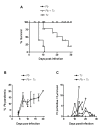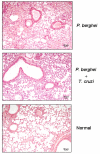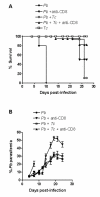Co-infection with Trypanosoma cruzi protects mice against early death by neurological or pulmonary disorders induced by Plasmodium berghei ANKA
- PMID: 17620126
- PMCID: PMC1965473
- DOI: 10.1186/1475-2875-6-90
Co-infection with Trypanosoma cruzi protects mice against early death by neurological or pulmonary disorders induced by Plasmodium berghei ANKA
Abstract
Objective: The objective of this study was to investigate whether the infection of C57BL/6 mice by P. berghei ANKA, which causes severe malaria, was modulated by co-infection with Trypanosoma cruzi.
Methods: Groups of C57BL/6 mice were infected either with P. berghei ANKA, T. cruzi strain G, or with both parasites. The presence of parasites was checked by microscopic examination of blood samples. Symptoms of neurological or respiratory disorders, as well as mortality, were registered. Breakdown of the blood brain barrier was determined by injecting the dye Evans blue. Histological sections of the lung were prepared and stained with hematoxilin-eosin.
Results: All mice infected only with P. berghei ANKA died within 7-11 days post-infection, either with symptoms of cerebral malaria or with respiratory abnormalities. The animals co-infected with T. cruzi strain G survived longer, without any of the referred to symptoms. Protection against the early death by severe malaria was effective when mice were given T. cruzi 15 days before P. berghei inoculation. Breakdown of the blood brain barrier and extensive pulmonary oedema, caused by malaria parasites, were much less pronounced in co-infected mice. The degree of protection to severe malaria and early death, conferred by co-infection with T. cruzi, was comparable to that conferred by treatment with anti-CD8 antibodies.
Conclusion: Co-infection with T. cruzi protects C57BL/6 against the early death by malaria infection, by partially preventing either the breakdown of the blood brain, and cerebral malaria as a consequence, or the pulmonary oedema.
Figures




Similar articles
-
Schistosoma co-infection protects against brain pathology but does not prevent severe disease and death in a murine model of cerebral malaria.Int J Parasitol. 2011 Jan;41(1):21-31. doi: 10.1016/j.ijpara.2010.06.008. Epub 2010 Aug 12. Int J Parasitol. 2011. PMID: 20708623
-
IL-10 plays a crucial role for the protection of experimental cerebral malaria by co-infection with non-lethal malaria parasites.Int J Parasitol. 2010 Jan;40(1):101-8. doi: 10.1016/j.ijpara.2009.08.009. Epub 2009 Sep 6. Int J Parasitol. 2010. PMID: 19735663
-
MDR1A (ABCB1)-deficient CF-1 mutant mice are susceptible to cerebral malaria induced by Plasmodium berghei ANKA.J Parasitol. 2008 Oct;94(5):1139-42. doi: 10.1645/GE-1493.1. J Parasitol. 2008. PMID: 18973419
-
Genetic analysis of cerebral malaria in the mouse model infected with Plasmodium berghei.Mamm Genome. 2018 Aug;29(7-8):488-506. doi: 10.1007/s00335-018-9752-9. Epub 2018 Jun 19. Mamm Genome. 2018. PMID: 29922917 Review.
-
Changes in brain metabolites in experimental cerebral malaria infection with plasmodium berghei ANKA: a literature review.J Pak Med Assoc. 2014 Oct;64(10):1179-85. J Pak Med Assoc. 2014. PMID: 25823161 Review.
Cited by
-
Trypanosoma brucei infection protects mice against malaria.PLoS Pathog. 2019 Nov 8;15(11):e1008145. doi: 10.1371/journal.ppat.1008145. eCollection 2019 Nov. PLoS Pathog. 2019. PMID: 31703103 Free PMC article.
-
Maladjusted host immune responses induce experimental cerebral malaria-like pathology in a murine Borrelia and Plasmodium co-infection model.PLoS One. 2014 Jul 30;9(7):e103295. doi: 10.1371/journal.pone.0103295. eCollection 2014. PLoS One. 2014. PMID: 25075973 Free PMC article.
-
Trypanosoma cruzi P21 recombinant protein modulates Toxoplasma gondii infection in different experimental models of the human maternal-fetal interface.Front Immunol. 2023 Oct 16;14:1243480. doi: 10.3389/fimmu.2023.1243480. eCollection 2023. Front Immunol. 2023. PMID: 37915581 Free PMC article.
-
Disruption of the blood-brain barrier in pigs naturally infected with Taenia solium, untreated and after anthelmintic treatment.Exp Parasitol. 2013 Aug;134(4):443-6. doi: 10.1016/j.exppara.2013.05.005. Epub 2013 May 15. Exp Parasitol. 2013. PMID: 23684909 Free PMC article.
References
-
- Buck AA, Anderson RI, Macrae AA. Epidemiology of poly-parasitism. IV. Combined effects on the state of health. Tropenmed Parasitol. 1978;29:253–268. - PubMed
-
- Tshikuka JG, Scott ME, Gray-Donald K, Kalumba ON. Multiple infection with Plasmodium and helminthes in communities of low and relatively high socio-economic status. Ann Trop Med Parasitol. 1998;90:277–293. - PubMed
Publication types
MeSH terms
LinkOut - more resources
Full Text Sources
Research Materials

